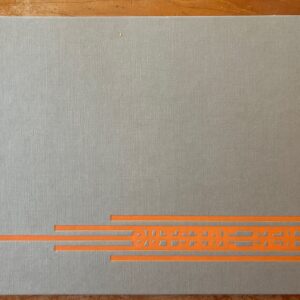JTF (just the facts): Published in 2024 by MACK Books (here). Softbound, with tipped in cover image and end flaps, 26 x 38 cm, 264 pages, with 232 photographs. Includes numerous texts by the artist. Design by Morgan Crowcroft-Brown. (Cover and spread shots below.)
Comments/Context: When we last checked in on Rosalind Fox Solomon, she had recently published her fourth photography monograph with MACK. In broad strokes, The Forgotten followed the model of its predecessors, collecting medium format black-and-white frames from her vast archive into a disorienting sequence. That book reaffirmed Solomon’s stature as one of photography’s greatest living portraitists, with a consistent ability to strip away the extraneous fluff of a person and pierce his or her essence. Her photographs reveled in disquieting details, expressions, and situations, and their unflinching veracity was sometime hard to stomach. “They’re uncomfortable to look at,” I conceded in Collector Daily‘s 2022 review (here). “The Forgotten is not exactly wall calendar material. The pictures penetrate far corners of the world with direct honestly, revealing latent truths that many viewers would prefer unearthed.”
For a photographer who has spent her career documenting various human forms, it was probably inevitable that Solomon would eventually turn the lens on herself. Enough prying into fellow earthlings. What makes her own clock tick? As it turns out, she’s been asking that exact question for decades. Solomon has been shooting herself regularly since she took up photography in 1968, but she’s largely kept the results to herself. Now at the age of 94, she’s finally decided to share her findings. Her latest MACK monograph A Woman I Once Knew—her largest since 2003’s Chapalingas—collects a thick stash of self-portraits covering a wide period of Solomon’s life, roughly the 1970s to the present.
The book’s aim may be internalized, but the uneasy mood of Solomon’s documentary portraiture remains. These selfies are far from glamorous. In fact they are often willfully frumpy. Solomon rarely smiles or shows enjoyment. In most pictures she glares at the camera with a glum expression. Her hair is typically uncombed, her lighting harsh, her posture slumped. Sometimes she crops her own body parts to show disfigured or bandaged limbs. One image zeroes in on a bloody nose. Another juxtaposes Solomon with mortuary cadavers. A day on the beach feels listless and disengaged. A winter shot near the wood pile feels cold and dispirited. Even when photographed with friends, we sense a vague disconnection. “I have always been an outsider on the inside,” she explains at one point. But really she needn’t verbalize anything. On the topic of alienation, her photographs speak volumes.
Oh yes, there is one more thing. A sizable portion of these self-portraits are nudes or semi-nudes. “I peeled back the outer coatings of my being,” she explains. Dispensing with clothes might be seen as a beeline to the core of a person. After all, garments are just one more barrier between subject and camera. But of course it’s not so easy to reduce skin to sightline logistics. Depictions of the nude female figure join a centuries-long tradition mixing beauty, cultural norms, aesthetic expectations, and impossible ideals. Applied to the self, they can sometimes take on a cathartic dimension, as demonstrated in recent photobooks of nude self-portraiture by Carla Williams (reviewed in exhibition form here), Melissa Shook (reviewed in exhibition form here), Yuri Yagashima (reviewed here), and Tarrah Krajnak (reviewed in exhibition form here).
Whereas these women photographed themselves as youthful figures, Solomon’s self-portraits begin in her forties and extend into her nineties. In some ways they recall the aging self-portraits of John Coplans, but not many women have probed this territory. In fact I cannot recall any photobook which matches A Woman I Once Knew’s sheer quantity of mature female nude self-portraits.
The photos come rapid-fire. At various points Solomon holds her breasts, frames her torso, squats with a shopping cart, and lies prone on the bed, among a range of inventive poses. In one sequence she bangs out a series of TV selfies aside the Shopping Channel. Most photos are shot in studio settings, but the locations vary widely. The only consistency is her presence, always unselfconscious and attentive. Here I am, her pictures say. Here is the human form. Here is the aging process. Here is the woman I once knew. Whatever geriatric preconceptions the reader might bring to her book, she seems determined to topple them with direct photographic evidence.
While Solomon’s photos pace her monograph in loose chronological order, much of its narrative weight is scaffolded on first-person prose. These texts—seemingly a blend of journal entries, poems, and diaristic memories— appear as regular excerpts throughout, interspersed in roughly equal measure with the pictures. In piecemeal fashion, they gradually accumulate into a nonagenarian timeline.
Not only does A Woman I Once Knew contain Solomon’s most extensive memoiristic prose to date, it also breaks with her past monographs in other ways. For the first time, she includes color photos, sketched sequences, contact sheets, and video still frames, all in an outsized vertical tome. At 94, and after several monographs, she is still tinkering with book formats and presentations.
The written passages sketch Solomon’s path to date, beginning in childhood with stern and judgmental parents, then continuing through various life stages: marriage, medical procedures, travel, jobs, divorce, self-discovery, and of course her portraiture. “I like people,” she explains in one journal entry. “I love them. But I’m also making comments on them and their values. I cannot be part of them. My strength lies in my ability to withstand social ostracism, solitude, and unpopularity. I am able to be blunt and honest in my work. I take on whatever attracts or interests me, regardless of the subject matter.”
Looming in the background are continual career challenges. As a photographer she was a late bloomer—she began at age 38—and her work has never gained widespread acclaim. A Woman I Once Knew garnered a rave review recently from Alec Soth and it was shortlisted for the Aperture/Paris Book Awards in October. That said, it seems unlikely to gain many new converts. Her books have always had an unsettling effect, and this one is no exception. Time and again she has taken the hard road to fame. “Whenever success loomed,” she writes of early exhibition opportunities, “I sabotaged it.” At another point she confesses thoughts of giving up entirely. “I have night thoughts of abandoning my career as a photographer.”
Those admissions exemplify her written impressions. They tend to be dour and self-recriminating, and occasionally wistful. In some ways they’re an extension of the impressionistic and oblique passages in her 2016 monograph Got To Go (reviewed in exhibition form here), which juxtaposed her portraits with unresolved maternal tensions. But unlike that book, A Woman I Once Knew ends on a brighter note. Things begin looking up in the last section when Solomon at last finds the right medication to help her depression. “No longer do I have extreme ups and downs. My relationships are good. My work goes well.”
Soon after this passage, she poses in a photo like a crouched boxer, fists at the ready, a competitor to the end. A few pages later she smiles warmly in a photo while hugging a young man (presumably her grandson or great-grandson?). The book’s last picture shows her leaning calmly against a “Solomon” tombstone. Has she finally made peace with herself and her life decisions? This visual coda would seem to infer so, and the book hints broadly in the same direction. A Woman I Once Knew is her most introspective and revealing work to date. If it becomes her swan song, it’s a fitting summary and tribute. Then again, knowing Solomon, she won’t fade into the woodwork so easily. There may yet be another disquieting monograph to come.
Collector’s POV: Rosalind Fox Solomon is represented by Stephen Bulger Gallery in Toronto (here) and Galerie Julian Sander in Cologne (here). Solomon’s work has not been routinely available in the secondary markets in recent years, so gallery retail likely remains the best option for those collectors interested in following up.


































